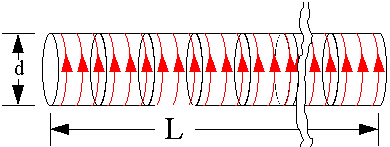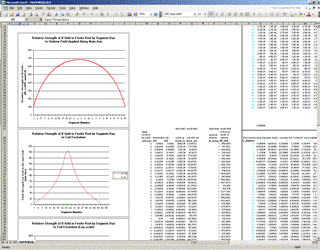
Ferrite Rod Receiving Loop Antenna Analysis and Modeling
A (Free !) Moment Method Code in Excel and Mathcad Spreadsheets for analyzing Ferrite Rod Receiving Antennas
{ For modeling of wire antennas see the free antenna modeling / antenna simulation program ASAP }
The "programs" are provided free in Excel and Mathcad spreadsheet formats order to promote greater awareness and use of ferrite antennas among students, amateur radio operators, professionals, etc. The spreadsheets can be freely exchanged between individuals and companies as long as it is not sold.
With these spreadsheets you can analyze Ferrite Rod antennas for properties such as:
- Field Induced in Rod by External Field (Receiving Case)
- Receive Voltage Pickup Factor of Coil on Rod vs. Air
- Inductance Ratio of Coil in Air to Coil on Rod
- Effect of Coil Position on Rod
Note that these are generally * ratios * and not the absolute numbers. Also note that I haven't really completed these pages so I haven't explained what any of these parameters mean (yet). See my apology for not getting more done and some comments on feedback I have received below.
Additional information on these programs and how to use them will be added from time to time.
The spreadsheets do not currently:
- account for magnetic material loss
- provide coil-in-air parameters (only ratios from them)
- phase corrections for rods that have dimentions that are a significant portion of a wavelength (usually not a problem)
PLEASE read all the documentation (such as it is) first before asking me a question.
|
 The Excel Spreadsheet version was created from the original Mathcad derived expressions. Due to limitations of Excel, only a fixed number segments in the analysis (i.e. 51) is used. This is sufficient for almost all problems at the level of the assumptions currently in play. It is saved in version 4.0 of Excel for maximum compatibility with the most users.
The Excel Spreadsheet version was created from the original Mathcad derived expressions. Due to limitations of Excel, only a fixed number segments in the analysis (i.e. 51) is used. This is sufficient for almost all problems at the level of the assumptions currently in play. It is saved in version 4.0 of Excel for maximum compatibility with the most users.
|
|
The Mathcad version is the presentation version of the original work done to create the quasi-static moment method solution. It contains a summary of the derivation in the worksheet. It is saved in version 6.0+ of Mathcad for maximum compatibility with the most users.
|
What is Mathcad?
A powerful Mathematics Spreadsheet Program
Goto Company Website Regrettably, due to the ever increasing price and the new owner company's apparent lack of interest in low-end home users and experimenters, I can no longer recommend this program as enthusiastically as I used to do; and am beginning to look for alternatives. |
| If you do not have Mathcad but would like to see the derivation or just what the sheet looks like, there is
{It is a "frozen" printout of one particular calculation so it will not give any new results - updated 20 May 2002 to remove a print problem in the first version (otherwise identical - I hope - to the first version)} |
Get Free Adobe Acrobat Reader Here |
Note from Ray 4 March 2003 (updated 3 September 2007):
Dear Page Readers,
I am sorry that I haven't updated these pages more frequently but I have been quite busy at work lately (still true in September 2007 - although I am still slowly working on an improvement).
Based on some email I have received I now know that the spreadsheet programs below will over predict the coil inductance ratios between ferrite loaded and air. This was to be expected since the calculations involve a simplifying assumption of a constant field across the cross section of the rod. It is actually surprising that this assumption works as well as it does. It works best with the rod immersed in the uniform field. The case of the coil on the rod is not as good.
I am working on an improved version of the program that will be much better in this regard. Unfortunately I don't get to work on it much because of other considerations like working overtime at work and helping with the new building project at church. The program is also more difficult than I hoped (but not more difficult than I expected) as it involves using the equivalence theorem to put equivalent surface currents on the ferrite rod. This involves some rather complicated (for me) integrals and making sure I understand everything. I have already attempted three variations on this but all were failures. I suspect I have still been trying to oversimplify too much to make it easier on my math skills.
Anyway, even though the answers are not as exact as I would like in the existing programs -- I still think that they are qualitatively useful to give some idea of what will happen in various cases.
It may take several months yet (or oops years) but I do plan on putting up some more information on this page (and the improved program) as time allows.
I have also posted an email reply to a question I got which may be of some interest. It includes both a question (and my answer) about noise reduction due to use of a ferrite loop, and an incomplete of a listing of ferrite rod / loop antenna references I have collected.
Thanks for your patience.
Ray
Enjoy,
Ray L. Cross,  , WK0O,
, WK0O,
BSEE, MSEE
and sometimes Webpage Curator
Back to Home Page
Last modified on:
Saturday 3 September 2007
 The Excel Spreadsheet version was created from the original Mathcad derived expressions. Due to limitations of Excel, only a fixed number segments in the analysis (i.e. 51) is used. This is sufficient for almost all problems at the level of the assumptions currently in play. It is saved in version 4.0 of Excel for maximum compatibility with the most users.
The Excel Spreadsheet version was created from the original Mathcad derived expressions. Due to limitations of Excel, only a fixed number segments in the analysis (i.e. 51) is used. This is sufficient for almost all problems at the level of the assumptions currently in play. It is saved in version 4.0 of Excel for maximum compatibility with the most users.
